Abarth Grande Punto 2010 Owner handbook (in English)
Manufacturer: ABARTH, Model Year: 2010, Model line: Grande Punto, Model: Abarth Grande Punto 2010Pages: 207, PDF Size: 3.01 MB
Page 101 of 207
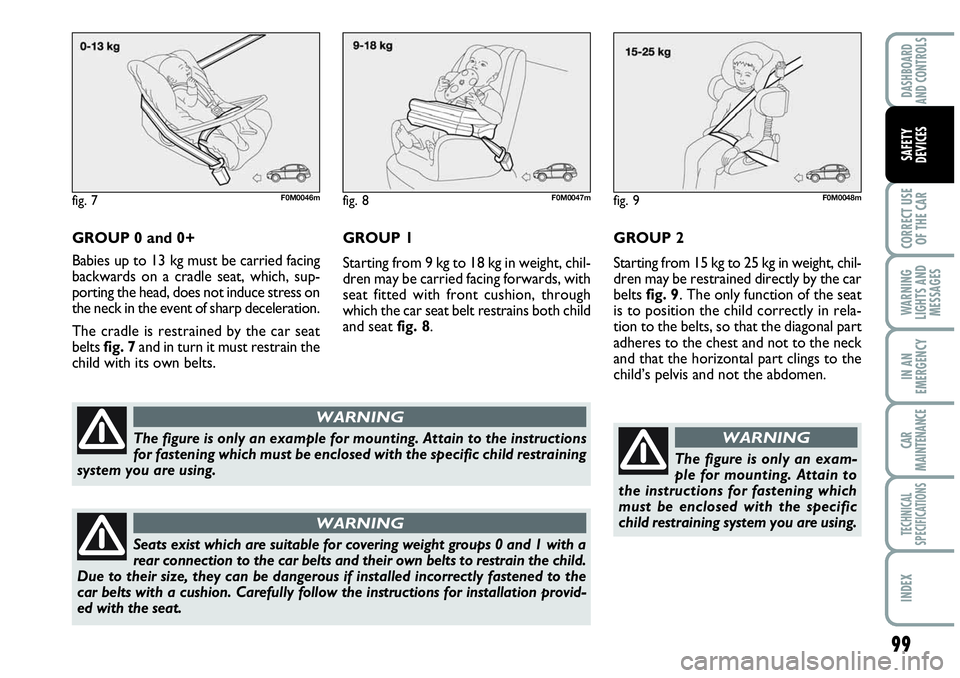
99
CORRECT USE
OF THE CAR
WARNING
LIGHTS AND
MESSAGES
IN AN
EMERGENCY
CAR
MAINTENANCE
TECHNICAL
SPECIFICATIONS
INDEX
DASHBOARD
AND CONTROLS
SAFETY
DEVICES
GROUP 0 and 0+
Babies up to 13 kg must be carried facing
backwards on a cradle seat, which, sup-
porting the head, does not induce stress on
the neck in the event of sharp deceleration.
The cradle is restrained by the car seat
belts fig. 7and in turn it must restrain the
child with its own belts.
The figure is only an example for mounting. Attain to the instructions
for fastening which must be enclosed with the specific child restraining
system you are using.
WARNING
Seats exist which are suitable for covering weight groups 0 and 1 with a
rear connection to the car belts and their own belts to restrain the child.
Due to their size, they can be dangerous if installed incorrectly fastened to the
car belts with a cushion. Carefully follow the instructions for installation provid-
ed with the seat.
WARNING
GROUP 2
Starting from 15 kg to 25 kg in weight, chil-
dren may be restrained directly by the car
belts fig. 9. The only function of the seat
is to position the child correctly in rela-
tion to the belts, so that the diagonal part
adheres to the chest and not to the neck
and that the horizontal part clings to the
child’s pelvis and not the abdomen. GROUP 1
Starting from 9 kg to 18 kg in weight, chil-
dren may be carried facing forwards, with
seat fitted with front cushion, through
which the car seat belt restrains both child
and seat fig. 8.
The figure is only an exam-
ple for mounting. Attain to
the instructions for fastening which
must be enclosed with the specific
child restraining system you are using.
WARNING
fig. 7F0M0046mfig. 8F0M0047mfig. 9F0M0048m
Page 102 of 207
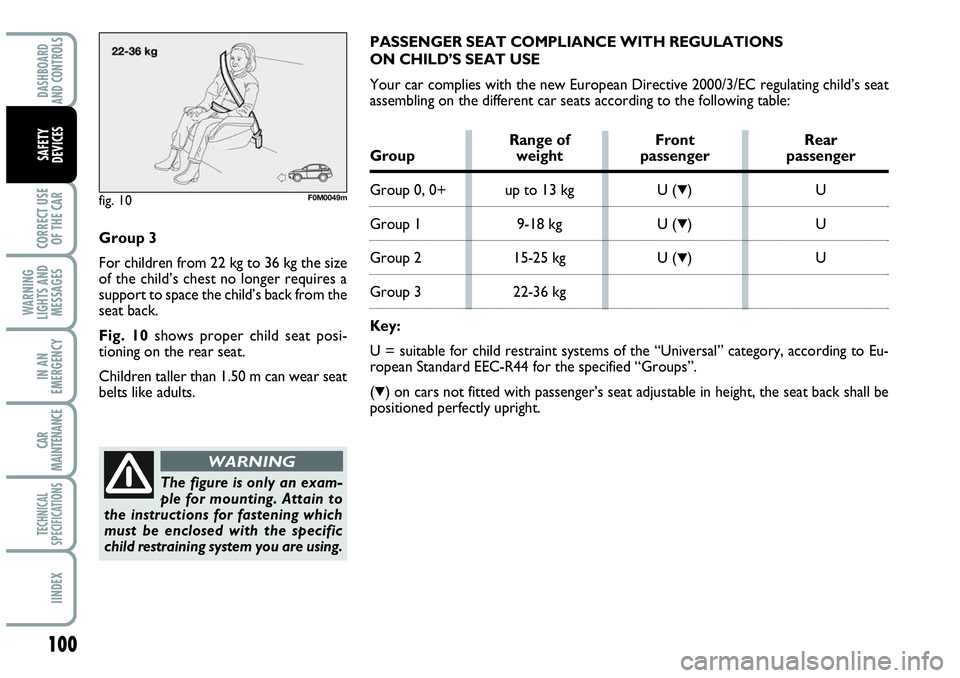
100
CORRECT USE
OF THE CAR
WARNING
LIGHTS AND
MESSAGES
IN AN
EMERGENCY
CAR
MAINTENANCE
TECHNICAL
SPECIFICATIONS
IINDEX
DASHBOARD
AND CONTROLS
SAFETY
DEVICES
Group 3
For children from 22 kg to 36 kg the size
of the child’s chest no longer requires a
support to space the child’s back from the
seat back.
Fig. 10shows proper child seat posi-
tioning on the rear seat.
Children taller than 1.50 m can wear seat
belts like adults.PASSENGER SEAT COMPLIANCE WITH REGULATIONS
ON CHILD’S SEAT USE
Your car complies with the new European Directive 2000/3/EC regulating child’s seat
assembling on the different car seats according to the following table:
The figure is only an exam-
ple for mounting. Attain to
the instructions for fastening which
must be enclosed with the specific
child restraining system you are using.
WARNING
fig. 10F0M0049m
Range of Front RearGroup weight passenger passenger
Group 0, 0+ up to 13 kg U (▼)U
Group 1 9-18 kg U (▼)U
Group 2 15-25 kg U (▼)U
Group 3 22-36 kg
Key:
U = suitable for child restraint systems of the “Universal” category, according to Eu-
ropean Standard EEC-R44 for the specified “Groups”.
(
▼) on cars not fitted with passenger’s seat adjustable in height, the seat back shall be
positioned perfectly upright.
Page 103 of 207
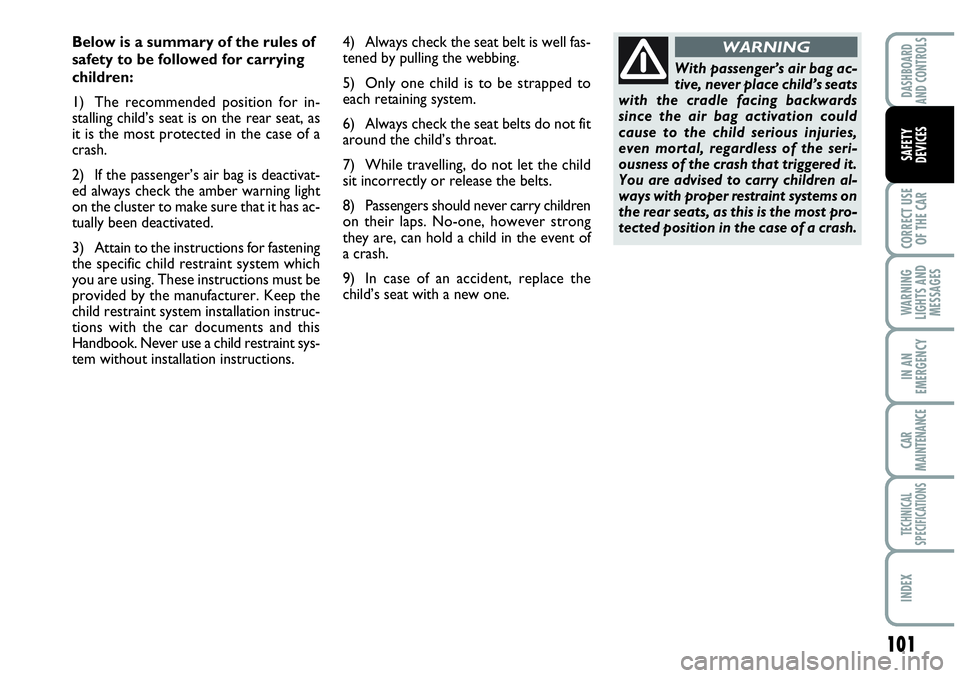
101
CORRECT USE
OF THE CAR
WARNING
LIGHTS AND
MESSAGES
IN AN
EMERGENCY
CAR
MAINTENANCE
TECHNICAL
SPECIFICATIONS
INDEX
DASHBOARD
AND CONTROLS
SAFETY
DEVICES
Below is a summary of the rules of
safety to be followed for carrying
children:
1) The recommended position for in-
stalling child’s seat is on the rear seat, as
it is the most protected in the case of a
crash.
2) If the passenger’s air bag is deactivat-
ed always check the amber warning light
on the cluster to make sure that it has ac-
tually been deactivated.
3) Attain to the instructions for fastening
the specific child restraint system which
you are using. These instructions must be
provided by the manufacturer. Keep the
child restraint system installation instruc-
tions with the car documents and this
Handbook. Never use a child restraint sys-
tem without installation instructions.4) Always check the seat belt is well fas-
tened by pulling the webbing.
5) Only one child is to be strapped to
each retaining system.
6) Always check the seat belts do not fit
around the child’s throat.
7) While travelling, do not let the child
sit incorrectly or release the belts.
8) Passengers should never carry children
on their laps. No-one, however strong
they are, can hold a child in the event of
a crash.
9) In case of an accident, replace the
child’s seat with a new one.
With passenger’s air bag ac-
tive, never place child’s seats
with the cradle facing backwards
since the air bag activation could
cause to the child serious injuries,
even mortal, regardless of the seri-
ousness of the crash that triggered it.
You are advised to carry children al-
ways with proper restraint systems on
the rear seats, as this is the most pro-
tected position in the case of a crash.
WARNING
Page 104 of 207
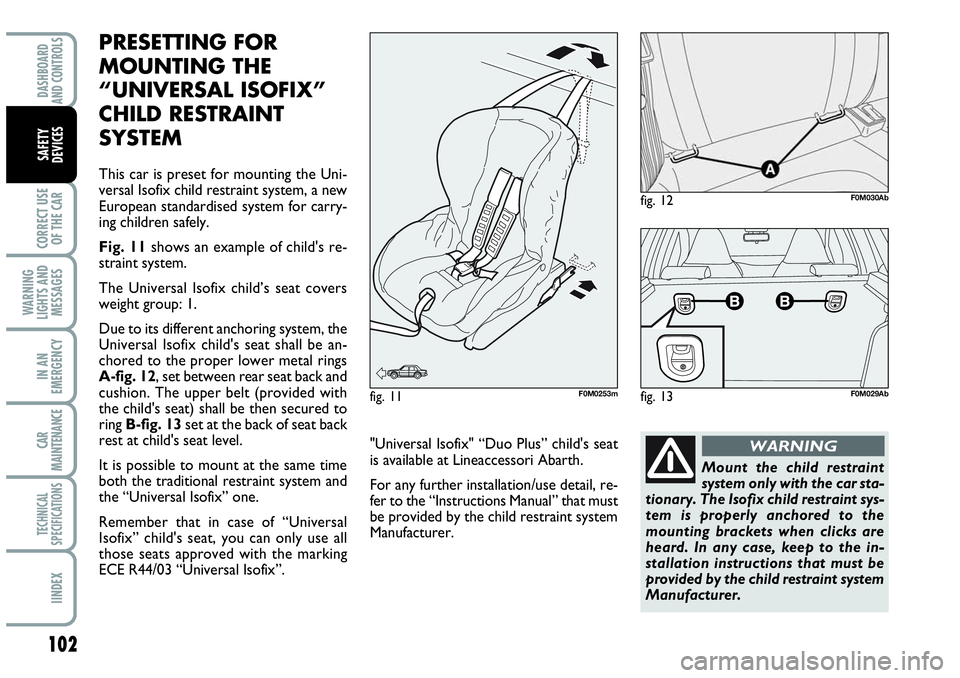
102
CORRECT USE
OF THE CAR
WARNING
LIGHTS AND
MESSAGES
IN AN
EMERGENCY
CAR
MAINTENANCE
TECHNICAL
SPECIFICATIONS
IINDEX
DASHBOARD
AND CONTROLS
SAFETY
DEVICES
PRESETTING FOR
MOUNTING THE
“UNIVERSAL ISOFIX”
CHILD RESTRAINT
SYSTEM
This car is preset for mounting the Uni-
versal Isofix child restraint system, a new
European standardised system for carry-
ing children safely.
Fig. 11shows an example of child's re-
straint system.
The Universal Isofix child’s seat covers
weight group: 1.
Due to its different anchoring system, the
Universal Isofix child's seat shall be an-
chored to the proper lower metal rings
A-fig. 12, set between rear seat back and
cushion. The upper belt (provided with
the child's seat) shall be then secured to
ring B-fig. 13set at the back of seat back
rest at child's seat level.
It is possible to mount at the same time
both the traditional restraint system and
the “Universal Isofix” one.
Remember that in case of “Universal
Isofix” child's seat, you can only use all
those seats approved with the marking
ECE R44/03 “Universal Isofix”.
Mount the child restraint
system only with the car sta-
tionary. The Isofix child restraint sys-
tem is properly anchored to the
mounting brackets when clicks are
heard. In any case, keep to the in-
stallation instructions that must be
provided by the child restraint system
Manufacturer.
WARNING"Universal Isofix" “Duo Plus” child's seat
is available at Lineaccessori Abarth.
For any further installation/use detail, re-
fer to the “Instructions Manual” that must
be provided by the child restraint system
Manufacturer.
fig. 12F0M030Ab
fig. 11F0M0253mfig. 13F0M029Ab
Page 105 of 207
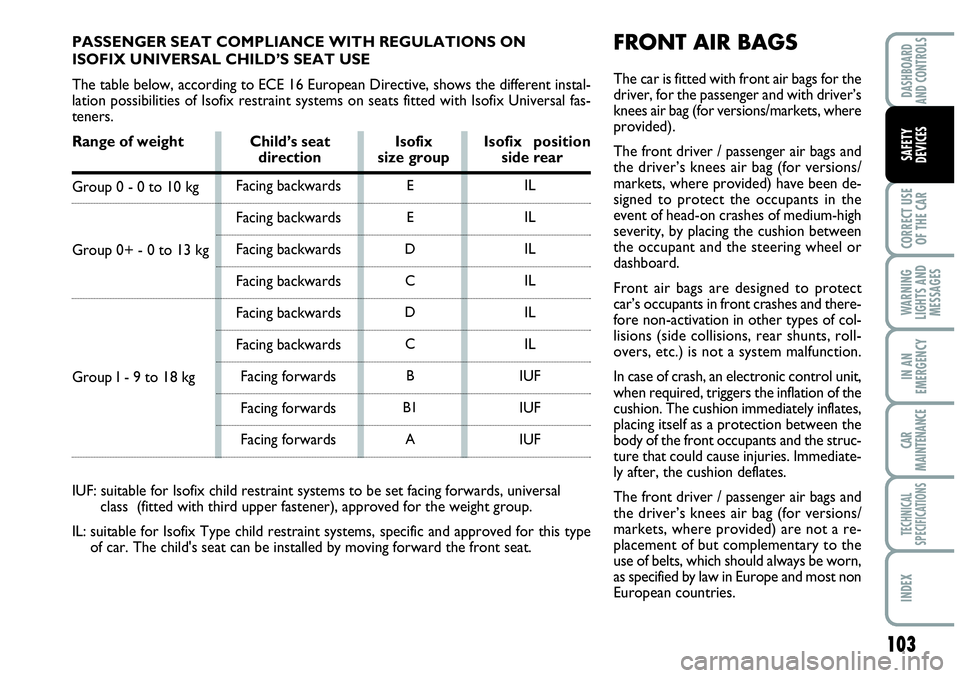
103
CORRECT USE
OF THE CAR
WARNING
LIGHTS AND
MESSAGES
IN AN
EMERGENCY
CAR
MAINTENANCE
TECHNICAL
SPECIFICATIONS
INDEX
DASHBOARD
AND CONTROLS
SAFETY
DEVICES
FRONT AIR BAGS
The car is fitted with front air bags for the
driver, for the passenger and with driver’s
knees air bag (for versions/markets, where
provided).
The front driver / passenger air bags and
the driver’s knees air bag (for versions/
markets, where provided) have been de-
signed to protect the occupants in the
event of head-on crashes of medium-high
severity, by placing the cushion between
the occupant and the steering wheel or
dashboard.
Front air bags are designed to protect
car’s occupants in front crashes and there-
fore non-activation in other types of col-
lisions (side collisions, rear shunts, roll-
overs, etc.) is not a system malfunction.
In case of crash, an electronic control unit,
when required, triggers the inflation of the
cushion. The cushion immediately inflates,
placing itself as a protection between the
body of the front occupants and the struc-
ture that could cause injuries. Immediate-
ly after, the cushion deflates.
The front driver / passenger air bags and
the driver’s knees air bag (for versions/
markets, where provided) are not a re-
placement of but complementary to the
use of belts, which should always be worn,
as specified by law in Europe and most non
European countries. Facing backwards
Facing backwards
Facing backwards
Facing backwards
Facing backwards
Facing backwards
Facing forwards
Facing forwards
Facing forwards
IL
IL
IL
IL
IL
IL
IUF
IUF
IUFE
E
D
C
D
C
B
B1
A
PASSENGER SEAT COMPLIANCE WITH REGULATIONS ON
ISOFIX UNIVERSAL CHILD’S SEAT USE
The table below, according to ECE 16 European Directive, shows the different instal-
lation possibilities of Isofix restraint systems on seats fitted with Isofix Universal fas-
teners.
Range of weight Child’s seat Isofix Isofix position
direction size group side rear
Group 0 - 0 to 10 kg
Group 0+ - 0 to 13 kg
Group I - 9 to 18 kg
IUF: suitable for Isofix child restraint systems to be set facing forwards, universal
class (fitted with third upper fastener), approved for the weight group.
IL: suitable for Isofix Type child restraint systems, specific and approved for this type
of car. The child's seat can be installed by moving forward the front seat.
Page 106 of 207

104
CORRECT USE
OF THE CAR
WARNING
LIGHTS AND
MESSAGES
IN AN
EMERGENCY
CAR
MAINTENANCE
TECHNICAL
SPECIFICATIONS
IINDEX
DASHBOARD
AND CONTROLS
SAFETY
DEVICES
PASSENGER’S FRONT AIR BAG
fig. 15
It consists of an instant-inflating cushion
contained into a special recess in the dash-
board, this cushion has a volume bigger
than that of the driver. In minor crashes (for which the restrain-
ing action of the seat belts is sufficient), the
air bags are not deployed. Also in this case
it is of vital importance to wear the seat
belts since in case of side crash they guar-
antee proper positioning of the occupant
and prevent the occupants to be pitched
out of the car in case of violent crashes.
DRIVER’S FRONT AIR BAG fig. 14
It consists of an instant-inflating cushion
contained in a special recess in the cen-
tre of the steering wheel.
Do not apply stickers or oth-
er objects to the steering
wheel or to the air bag cover on the
passenger’s side or on the side roof
lining. Never put objects (e.g. mobile
phones) on the dashboard on pas-
senger side since they could interfere
with proper air bag inflation and al-
so cause serious injury.
WARNINGThe volume of front air bags at max. in-
flation fills most of the space between the
steering wheel and the driver and between
the dashboard and the passenger.
In case of crash, a person not wearing the
seat belt moves forward and may come in-
to contact with the cushion while it is still
inflating. Under this circumstance the pro-
tection offered by the air bag is reduced.
Front air bag may not be activated in the
following situations:
❒in collisions against highly deformable
objects not affecting the car front sur-
face (e.g. bumper collision against guard
rail, etc.);
❒ in case of wedging under other vehicles
or protective barriers (for example un-
der a truck or guard rail), the air bag
is not triggered as it offers no additional
protection compared with the seat
belts, consequently it would be point-
less. Therefore, failure to come into ac-
tion in the above circumstance does
not mean that the system is not work-
ing properly.
fig. 14F0M031Ab
fig. 15F0M032Ab
Page 107 of 207

105
CORRECT USE
OF THE CAR
WARNING
LIGHTS AND
MESSAGES
IN AN
EMERGENCY
CAR
MAINTENANCE
TECHNICAL
SPECIFICATIONS
INDEX
DASHBOARD
AND CONTROLS
SAFETY
DEVICES
MANUAL DEACTIVATION OF
PASSENGER’S FRONT AIR BAG
AND SIDE BAG
(for versions/markets,
where provided)
Should it be absolutely necessary to car-
ry a child on the front seat, the passenger’s
front air bag and the Side Bag (for ver-
sions/markets, where provided) can be de-
activated.
The instrument panel warning light “will
stay on glowing steadily until reactivating
the passenger’s front air bag and the Side
Bag (for versions/markets, where provid-
ed).
SERIOUS DANGER: With
passenger’s air bag active
(ON), never place child’s
seats with the cradle facing
backwards since the air bag
activation could cause to
the child serious injuries, even mortal.
In the case of need, always deactivate
the passenger’s air bag when a child’s
seat is placed on the front seat. The
front passenger’s seat shall be ad-
justed in the most backward position
to prevent any contact between
child’s seat and dashboard. Even if
not compulsory by law, you are rec-
ommended to reactivate the air bag
immediately as soon as child trans-
port is no longer necessary.
WARNING
To deactivate the passen-
ger’s front air bag and the
Side Bag (for versions/markets, where
provided), refer to paragraph “Re-
configurable multifunction display” in
section “Dashboard and controls”.
WARNING
Page 108 of 207

SIDE AIR BAGS
The car is fitted with front side bags for
driver and passenger (for versions/ mar-
kets, where provided) for protecting the
chest and window bags (for versions/ mar-
kets, where provided) for protecting front
and rear passengers’ head.
Side bags (for versions/markets, where
provided) protect car occupants from side
crashes of medium-high severity, by plac-
ing the cushion between the occupant and
the internal parts of the side structure of
the car.
Non-activation of side bags in other types
of collisions (front collisions, rear shunts,
roll-overs, etc...) is not a system malfunc-
tion.
In case of side crash, an electronic control
unit, when required triggers the inflation
of the cushion. The cushion immediately
inflates, placing itself as a protection, be-
tween the occupant’s body and the struc-
ture that could cause injuries. Immediate-
ly after, the cushion deflates.
Side bags (for versions/markets, where
provided) are not a replacement of but
complementary to the belts, which you
are recommended to always wear, as
specified by law in Europe and most non-
European countries.FRONT SIDE BAGS - CHEST
AND PELVIS ZONE
PROTECTION fig. 16
(for versions/markets,
where provided)
Front side bags are housed in the seat back
rests, they consist of an instant inflation
cushion designed to increase protection
of the occupants’ chest and pelvis zone in
the event of a side crash of medium-high
severity.SIDE WINDOW BAGS - HEAD
PROTECTION fig. 17
(for versions/markets,
where provided)
They consist of two “curtain” cushions,
one on the right and the other on the left
side of the car, located behind the side
coverings of the roof and covered by
proper finishing.
Window bags have been designed for pro-
tecting the head of front and rear occu-
pants in the event of side crash, thanks to
the wide cushion inflation surface.
IMPORTANT In the event of side crash,
you can obtain the best protection by the
system keeping a correct position on the
seat, allowing thus a correct window bag
unfolding.
106
CORRECT USE
OF THE CAR
WARNING
LIGHTS AND
MESSAGES
IN AN
EMERGENCY
CAR
MAINTENANCE
TECHNICAL
SPECIFICATIONS
IINDEX
DASHBOARD
AND CONTROLS
SAFETY
DEVICES
fig. 16F0M033Abfig. 17F0M0141m
Page 109 of 207
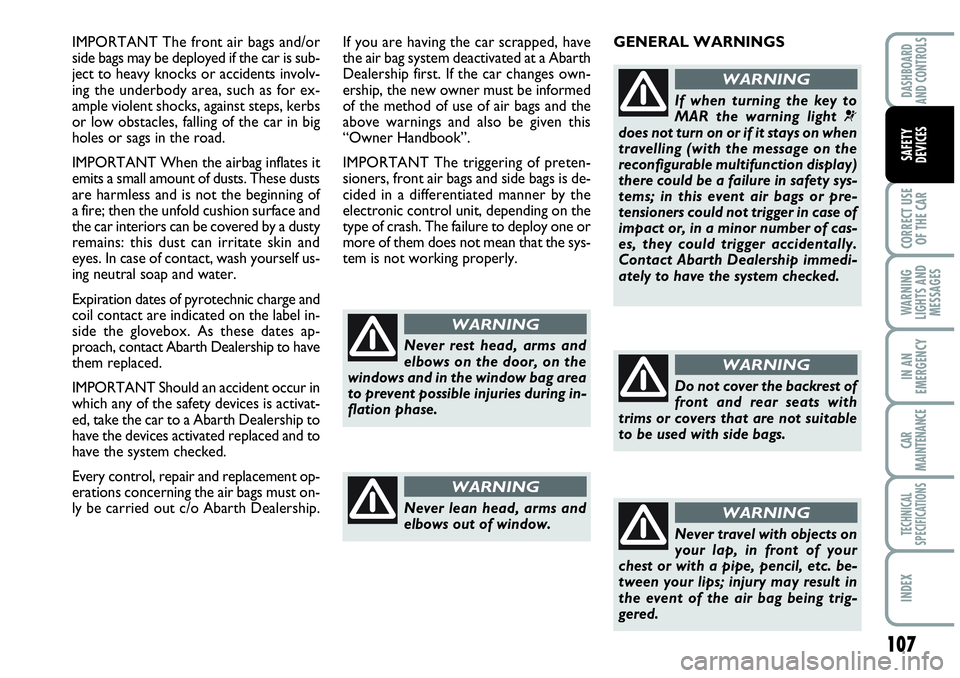
107
CORRECT USE
OF THE CAR
WARNING
LIGHTS AND
MESSAGES
IN AN
EMERGENCY
CAR
MAINTENANCE
TECHNICAL
SPECIFICATIONS
INDEX
DASHBOARD
AND CONTROLS
SAFETY
DEVICES
IMPORTANT The front air bags and/or
side bags may be deployed if the car is sub-
ject to heavy knocks or accidents involv-
ing the underbody area, such as for ex-
ample violent shocks, against steps, kerbs
or low obstacles, falling of the car in big
holes or sags in the road.
IMPORTANT When the airbag inflates it
emits a small amount of dusts. These dusts
are harmless and is not the beginning of
a fire; then the unfold cushion surface and
the car interiors can be covered by a dusty
remains: this dust can irritate skin and
eyes. In case of contact, wash yourself us-
ing neutral soap and water.
Expiration dates of pyrotechnic charge and
coil contact are indicated on the label in-
side the glovebox. As these dates ap-
proach, contact Abarth Dealership to have
them replaced.
IMPORTANT Should an accident occur in
which any of the safety devices is activat-
ed, take the car to a Abarth Dealership to
have the devices activated replaced and to
have the system checked.
Every control, repair and replacement op-
erations concerning the air bags must on-
ly be carried out c/o Abarth Dealership.If you are having the car scrapped, have
the air bag system deactivated at a Abarth
Dealership first. If the car changes own-
ership, the new owner must be informed
of the method of use of air bags and the
above warnings and also be given this
“Owner Handbook”.
IMPORTANT The triggering of preten-
sioners, front air bags and side bags is de-
cided in a differentiated manner by the
electronic control unit, depending on the
type of crash. The failure to deploy one or
more of them does not mean that the sys-
tem is not working properly.
Never rest head, arms and
elbows on the door, on the
windows and in the window bag area
to prevent possible injuries during in-
flation phase.
WARNING
Never lean head, arms and
elbows out of window.
WARNING
GENERAL WARNINGS
If when turning the key to
MAR the warning light ¬does not turn on or if it stays on when
travelling (with the message on the
reconfigurable multifunction display)
there could be a failure in safety sys-
tems; in this event air bags or pre-
tensioners could not trigger in case of
impact or, in a minor number of cas-
es, they could trigger accidentally.
Contact Abarth Dealership immedi-
ately to have the system checked.
WARNING
Do not cover the backrest of
front and rear seats with
trims or covers that are not suitable
to be used with side bags.
WARNING
Never travel with objects on
your lap, in front of your
chest or with a pipe, pencil, etc. be-
tween your lips; injury may result in
the event of the air bag being trig-
gered.
WARNING
Page 110 of 207
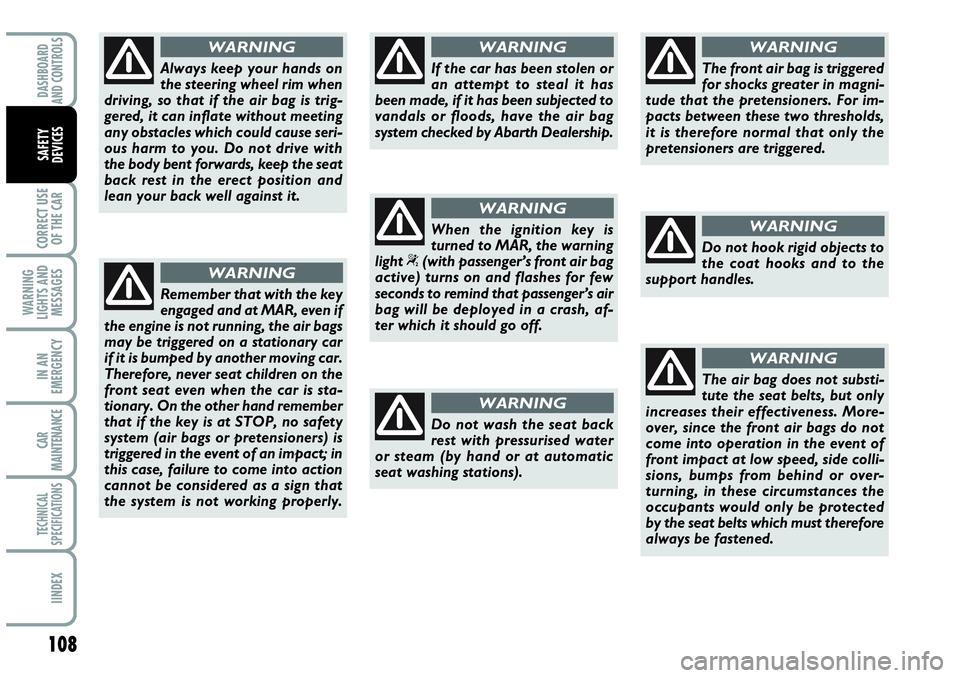
108
CORRECT USE
OF THE CAR
WARNING
LIGHTS AND
MESSAGES
IN AN
EMERGENCY
CAR
MAINTENANCE
TECHNICAL
SPECIFICATIONS
IINDEX
DASHBOARD
AND CONTROLS
SAFETY
DEVICES
Always keep your hands on
the steering wheel rim when
driving, so that if the air bag is trig-
gered, it can inflate without meeting
any obstacles which could cause seri-
ous harm to you. Do not drive with
the body bent forwards, keep the seat
back rest in the erect position and
lean your back well against it.
WARNING
Remember that with the key
engaged and at MAR, even if
the engine is not running, the air bags
may be triggered on a stationary car
if it is bumped by another moving car.
Therefore, never seat children on the
front seat even when the car is sta-
tionary. On the other hand remember
that if the key is at STOP, no safety
system (air bags or pretensioners) is
triggered in the event of an impact; in
this case, failure to come into action
cannot be considered as a sign that
the system is not working properly.
WARNING
Do not wash the seat back
rest with pressurised water
or steam (by hand or at automatic
seat washing stations).
WARNING
The front air bag is triggered
for shocks greater in magni-
tude that the pretensioners. For im-
pacts between these two thresholds,
it is therefore normal that only the
pretensioners are triggered.
WARNING
Do not hook rigid objects to
the coat hooks and to the
support handles.
WARNING
The air bag does not substi-
tute the seat belts, but only
increases their effectiveness. More-
over, since the front air bags do not
come into operation in the event of
front impact at low speed, side colli-
sions, bumps from behind or over-
turning, in these circumstances the
occupants would only be protected
by the seat belts which must therefore
always be fastened.
WARNING
When the ignition key is
turned to MAR, the warning
light “(with passenger’s front air bag
active) turns on and flashes for few
seconds to remind that passenger’s air
bag will be deployed in a crash, af-
ter which it should go off.
WARNING
If the car has been stolen or
an attempt to steal it has
been made, if it has been subjected to
vandals or floods, have the air bag
system checked by Abarth Dealership.
WARNING